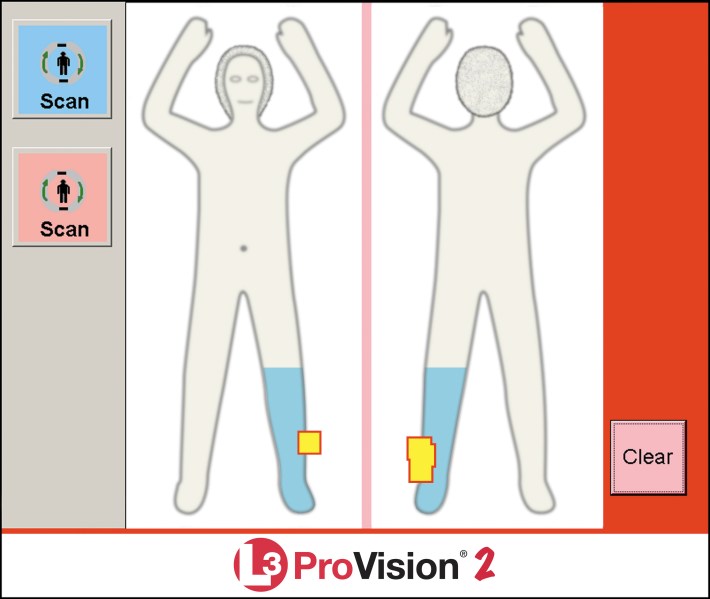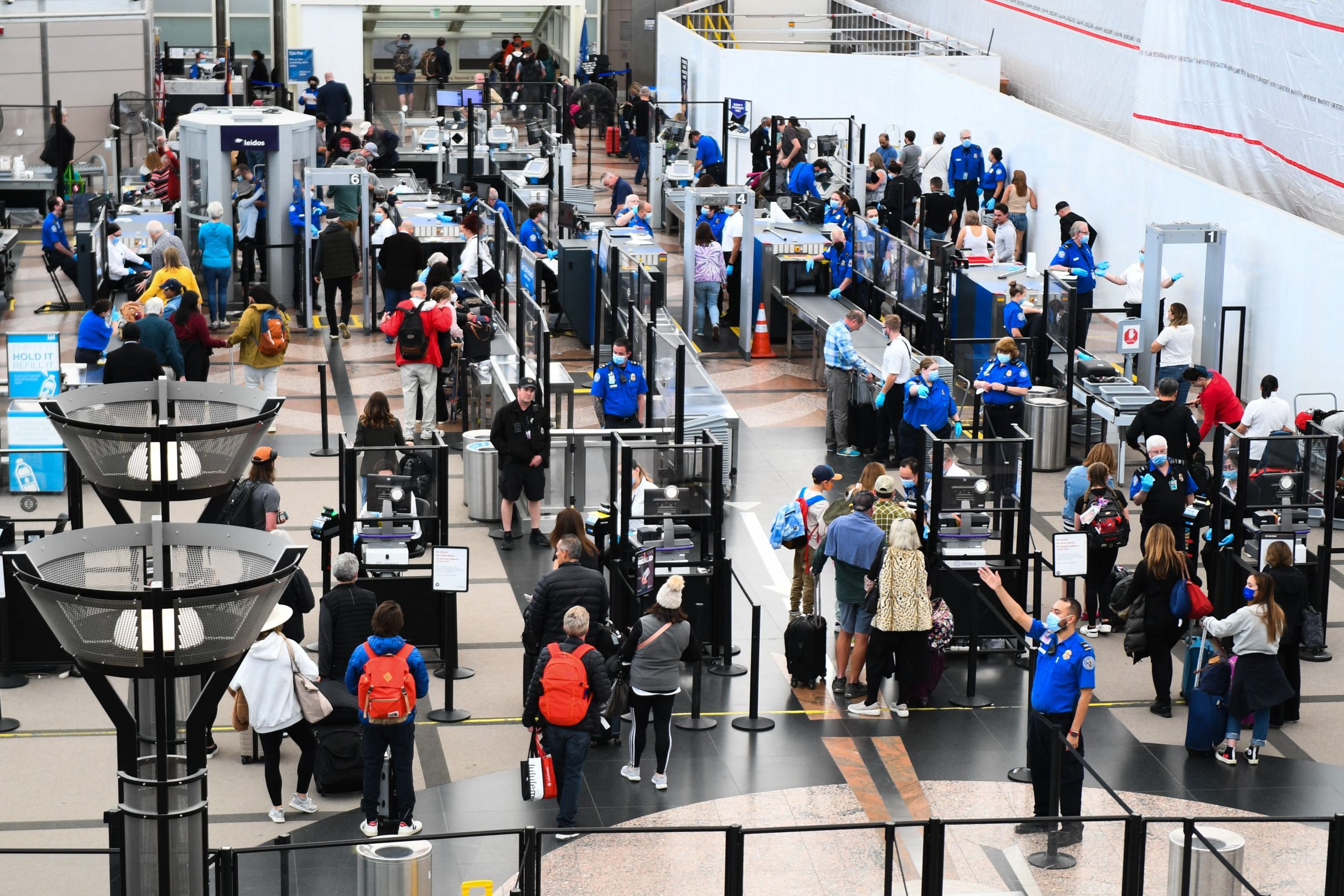An Introduction to the L3 ProVision 2
If you've flown in the last decade, you've likely been through this, though if you're cis you probably haven't given its brand name a second thought. These L-3 scanners became standard in 2013, after a massive public outcry over TSA's old machines, which sent a kind of nude x-ray image of airline passengers for agents to study for so-called potential threats. These ones, instead, use "Automated Target Recognition software," which simply maps little threat boxes onto crude, impersonal renderings of people.
If you've never paid close attention after walking through the semi-enclosed tube and angling your arms above your head, the TSA agent sees something like this, which would indicate that your left leg needs a pat-down.

What you'll also probably notice here is that there is a blue scan button and a pink scan button. Because this system was not designed by anyone with even the slightest concept of gender's complexity, the blue scan button is for boys and the pink scan button is for girls. You don't see this because you're in the tube, but every time someone at the airport steps up to get scanned, the TSA agent working this machine has to look at them and decide their gender. That extra bit of manually inputted information, in theory, helps the scanner differentiate genitals (permitted) from guns and bombs (not permitted). Innovation!
The Problem
The most serious problem is just that this shit doesn't seem to work. TSA has regularly posted abysmal success rates when met with undercover security tests, and these scanners stand tall as hollow, expensive symbols of 21st century American security theater. But I have a much more personal beef with them. This issue would have started in late 2017 or early 2018, I suppose. That was my first year of physically transitioning as a trans woman, and for those who haven't experienced it, it's a weird frickin' time. Not only is your body literally undergoing a second puberty, but the way strangers react to you is just completely all over the map and impossible to predict. Some just see a boy. Some see a girl. Some see a boy they want to yell slurs at. Many are just confused. All of that rubs off on your own self-image, which more often than not boils down to to "dumb unmanageable blob." It's a tough uphill climb to get to a place where you're relatively OK being looked at and seen on a day-to-day basis.
The first time a TSA agent pressed the pink button for me, I was totally unaware that their scanners required gendering every single person who stepped into their little security tube; I also didn't know what happened if you set them off. Thus, I was too surprised and nervous to voice any objection as they ran me through a script I'd eventually memorize. I was asked if I wanted to be searched in the open or in a private room, and for the sake of speed I said right here is fine. I was then asked if I had a preference for the gender of the person who searched me, and to avoid causing any tension or pressure I said it didn't matter. Then the agent told me how her gloved hands would move along my upper leg, waist, and groin areas before putting me through that discomfort for real. Then my hands were swabbed for, I guess, bomb residue. After that, having cleared all stages, I got my luggage from the conveyor belt while absorbing all kinds of curious and aggrieved stares from the rest of the line. That first time, I'm pretty sure I heard the TSA agent's partner tell her, "I told you so."
As this happened more and more, I gained some knowledge about how various cis people react when suddenly confronted with the existence of an undeniably trans person in a vulnerable situation. The ones I liked the least grilled me with questions about my identity under the guise of trying to avoid offense. The ones I didn't mind just exuded an aura of disengaged frustration, quietly annoyed that I was pulling them out of the easy, button-pushing routine of their jobs. The nicest ones at least tried to show some empathy for my ordeal, giving compliments or engaging me in small talk about my travels, although I ended up resenting them almost as much as the rest for inflicting the same ritual upon me, albeit with an apologetic smile.
The only one I'm anything like grateful for, in retrospect, was the older woman in I think Chicago who helped me realize that this was not a routine I needed to silently suffer for the rest of the foreseeable future. At this point, my strategy was to try and completely disengage from my body and walk through TSA like an unfeeling zombie, with all the defense mechanisms that keep my mind from being too aware of my body fortified multiple times over. I didn't even realize what she was talking about at first when she said, "Oh, honey, you're shaking," in the kind of tone you'd use to address a three-legged dog.
"This is my least favorite part of flying," I squeaked out during my brief reappearance in myself, as her hands moved up my leg.
The Solution
As much as I appreciated the U.S. Department of Homeland Security's unshakable belief that my junk was a weapon that presented a grave threat to national security, I tried to develop some strategies to keep things nice and distanced between me and TSA. I initially attempted looking like a boy as much as possible when I flew, but I'm sort of proud to say that just straight-up failed and the agent pressed the pink anyway. I tried explaining the situation to the agent before they did the scan, but that was just messy, both because talking in the tube seems to be frowned upon and because I could never hit on a concise collection of words that could spell out the impending problem to someone completely unprepared for it. It was like asking an infant if it needed to use the bathroom before a long drive.
But in the recent instances when I've flown and been stuck in the scanners instead of the basic metal detectors they sometimes open up during busy times, I've managed to use my acquired understanding of TSA's machines and its procedures to escape any invasive touching. While I don't feel anywhere near comfortable saying that this will work universally, or even just for me all the time, this is my best and most proven strategy, and I will keep using it going forward.
- Be completely quiet and normal through the entirety of the scan. Do nothing to differentiate myself from any other passengers.
- When I step out of the machine, watch the scanner image pop up alongside the agent. React with no surprise or confusion whatsoever when my groin is flagged. Immediately ask the agent, in a slightly lower tone of voice than I usually use, "Do you want to change the gender and try again?" Inch back toward the machine as they try to comprehend the glaring flaw in their technology.
- Take the scan again. This time, it's probable that something in my upper body will be flagged—it must be a bra or chest-related bug. This presents what could be an infuriating catch-22 for trans women. But in my case—perhaps because I've already passed the other test in that area—I've never received anything more than a chill, perfunctory brush along my shoulder and upper arm, which is much, much better than the previous alternative.
It's cool and interesting, to me at least, that walking through a scary environment got easier for me when I adopted a facade of unassuming confidence instead of mousy submissiveness. A lot of folks still get flustered by the unexpected appearance of someone who doesn't conform to gender norms, and a lot of folks also don't want to do extra work at their job. So as long as I don't jump too far ahead of myself, and I wait for the obvious problems to actually arise before trying to solve them, I can take advantage of both these traits to chip away at just a bit of the horror of the flying experience.
Hopefully if you're cis and read all the way down here, there's some lesson you can take from my experience and apply more generally. If not, at least you have further proof that TSA is stupid as hell and is wasting all your tax money.





